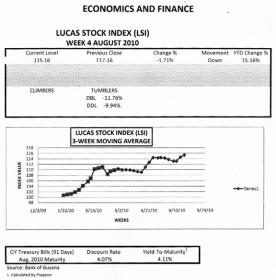Tough Choices
After five years of double-digit increases in borrowing, Guyanese households may have lost their appetite for borrowing to spend on themselves and their homes. According to data released by the Bank of Guyana in its June 2010 Statistical Abstract, Guyanese households decreased their borrowing by six percent compared to June 2009. This change in household attitude to debt reverses a trend of the last five years where households appeared willing to increase their obligations to the commercial banks by an annual average of 19 percent from 2005 to 2009. This year therefore marks the first time within the last five years that households do not seem to be relying on bank funds to make much needed purchases. The largest increase in borrowing was recorded in 2008 when household spending was bolstered by a 23 percent increase in money obtained from the banks. This favourable trend was halted in 2009 when consumers slowed their borrowing to an increase of about 10 percent over June 2008. This is not a good sign for the economy since household spending accounts for more than half of the spending in the Guyana economy and Guyanese were sustaining their purchases with the borrowed funds. If 2009 is any guide, when Guyanese consumers were forced to reduce their consumption substantially, then some tough choices are being made under the “bottom house” and in the kitchens of Guyanese homes this year.

Identifiable Categories
Guyanese households borrow money to purchase a range of goods and services. According to the Bank of Guyana, households take money from the banks for a variety of reasons. They borrow money to purchase cars, to improve their homes, to spend on education, to travel, to buy durable goods such as furniture and washing machines, and for several other purposes. The largest identifiable categories of household spending are home improvement and motor vehicles. They are the principal reasons that households go to the banks for money. Over the past five years, money to make improvements to houses accounted for an average of 32 percent of the funds taken from the banks. The purchase of motor cars accounted for an average of 26 percent of the borrowed funds by households over the same time period. The miscellaneous category of items which could include medical expenses accounted for about 34 percent of household borrowing during the period in review. Within the last two years, this miscellaneous category of items ballooned and is responsible for nearly 50 percent of the borrowed funds. Less money, about two percent, is borrowed for education. The smallest share of identifiable household debt is the travel budget. It continues to account for less than half of one percent of the money owed to commercial banks.
Sign of Difficulty
From June 2006 to June 2009, the funds that households borrowed from the banks made up about 20 percent of the funds that were loaned to the private sector. Except for real estate mortgages, no other grouping in the private sector has been borrowing more than households. The money used by this group of consumers makes up an estimated 10 percent of the money supply of the country. As a sign that households are finding it difficult to maintain the borrowing trend of the last five years, household loans as a share of private sector borrowing have fallen significantly. From June 2009 to June 2010, household loans accounted for 15 percent of private sector borrowing and eight percent of the nation’s money supply, a decline of five and two percentage points respectively.
Decline in Spending
With the exception of motor cars and travel, all the other categories of household spending were affected by the slowdown in borrowing. The amount of money acquired from the banks for home improvement declined by seven percent from June 2009 to June 2010. Guyanese used less borrowed funds to purchase durables and other types of goods and services. Funds to buy durables fell by 21 percent, while funds used on miscellaneous goods and services fell by 15 percent. Funds used for education purposes registered a marginal decline. The only two categories that saw increased borrowing were travel, which barely registers a blip on the credit screen, and motor cars. Borrowing by households to buy motor cars registered an 18 percent increase in the debt obligations of households from June 2009 to the corresponding period in 2010. A possible indication of the demand for car loans is that Guyanese registered nearly 2000 private cars with the Licence Revenue Office in the second half of 2009. This represented a 15 percent increase in registration of cars over the first half of 2009, the year for which figures are available.
However, the positive movements in the outstanding debt of Guyanese were not enough to maintain the impact of households on the money supply. Unless incomes are rising significantly and remittances are increasing, the decline in borrowing means that there is a decline in spending by households. Under such circumstances, it was unlikely that the Guyana economy would do better than it did last year.
New Attitude
It is not clear what is forcing the change in attitude among household borrowers. It is quite likely that households might have become more sensitive to changes in interest rates, and the decline in borrowing is being influenced by the successive increases in the interest rates charged by commercial banks. While interest rates vary among banks, according to the Bank of Guyana, the average lending rates of the commercial banks in Guyana rose from 11.69 percent in June 2009 to 12.34 percent in November 2009. During this short period, the cost of money to households rose by an average of six percent. The lending rates have fluctuated since November 2009 and, even though rates declined to 12.03 percent in June 2010, the earlier increases might have dampened the enthusiasm of households for borrowing from the commercial banks. If that is the case, then it represents a significant shift in attitude since interest rates were comparatively higher during the period of expanded borrowing.
The increase in borrowing continued in 2006 when borrowing went up by 20 percent. The good times continued from June 2006 to June 2007 as borrowing by households grew at the even faster pace of 34 percent. Even though the rate of increase has slowed somewhat, households increased their outstanding balances with the commercial banks by an additional 25 percent within the last year.
Share of Credit
The sustained growth in borrowing pushed the share of private sector credit held by households from around 16 percent in 2004 to about 23 percent by June of this year.
This figure was up from 21 percent in 2007 and from an average of 20 percent in 2005 and 2006 respectively. If the trend is anything to go by, bank credit is becoming an increasingly important factor in consumer spending. One piece of evidence is the average loan balance per household. In 2004, the average loan balance was about G$303,000 and, by my estimate, is now close to G$400,000.
Disclosure
With Guyanese households holding nearly a quarter of the value of a major income-generating asset of the commercial banks, there is interest in what the money is being used for. The disclosure of this information has implications for future borrowers, lenders and even local entrepreneurs.
Potential borrowers might want to know which of their preferred expenditures was likely to be favourably considered by lenders. Published information makes this possible. The lenders themselves ought to be interested in knowing which of their products offers the best opportunity for increasing their asset base and generating sustainable returns with the least risk. Local entrepreneurs should be curious too if only to put themselves in a position to assess market potential and to develop strategies for tapping into that potential. The data coming from official sources aid investors in that task.
According to the Bank of Guyana, the money obtained by households from the banking system is spent on housing, motor cars, durable goods, education and travel. Data provided by the commercial banks indicate that personal loans are often used also to cover such things as medical care, engagements and weddings. In my view, these choices reflect the personal preferences and needs of individual borrowers and some of the products on which banks are willing to bet part of their investment stakes.
Realignment
Local entrepreneurs should not turn a blind eye to the converging interests between banks and their customers for several reasons.
One, while the bulk of bank loans go to the business community, the realignment of the loan portfolio of banks in favour of households is unmistakable. Eight years ago, the three sectors of manufacturing, agriculture and mining, for example, accounted for 48 percent of private sector debt. This amount was three times as much debt as was held by households at that time. Today, the three sectors combined hold only 18 percent of private sector debt or 22 percent less debt than is held by Guyanese households.
Opportunity
Two, the composition of the debt portfolio of households may reverse at a later date but the current allocation gives an indication as to where the greatest potential for business opportunity exists.
For example, over the last five years, Guyanese spent an average of one-third of the money that they borrowed on housing. This expenditure involves home improvement or repairs and maintenance of existing structures. Even though borrowing for this purpose seems to have peaked in 2005 and stabilized within the last two years, it remains the biggest reason households go to the banks, a fact worth noting by building contractors. Contractors should keep in mind also that spending on new housing construction is usually viewed as an investment and any renewal or upgrading of the investment would be viewed positively.
Other examples of household debt with favorable business potential are car sales and travel. Car loans account for 27 percent of what households owe the banks, the next highest share of household debt. The current value of car debt represents an 18 percent increase on the amount that was owed to the banks in 2004. Despite this significant change in share of credit from four years ago, the dollar amount borrowed to buy motor cars peaked in 2006 and, as with housing, has remained stable since then. Nonetheless, the size of the debt is proof that banks are willing to fund such sales. Enterprising entrepreneurs with a good business strategy may be able to compete successfully in this market if they can find creditworthy customers.
At the other end of household debt is travel. Debt for travel purposes is beginning to take hold and appears to be gaining in popularity as outstanding balances grow at impressive speeds. Borrowing grew by 26 percent in 2006, by 32 percent in 2007 and by 40 percent in 2008.
In my view, the trend in credit for travel is an area to which operators in the hospitality and tourist industry should pay close attention. Here is why. The share of household credit for travel may be small at this point in time, but the speed of its growth indicates a growing willingness on the part of banks to lend for that purpose. Tourist operators who are struggling to attract foreign visitors may want to consider courting the internal market. Investors with a business model that emphasizes domestic tourism could be in a position to take advantage of households that are willing to borrow and undertake internal travel.
Reality Check
While the preceding discussion offers optimism for entrepreneurs, the internal numbers on household borrowing provide a dose of reality. Guyana does not produce motor cars; nor does it produce most of the items used in housing construction or fixtures used in homes; nor does Guyana operate a national airline. Given this situation, it is conceivable that the bulk of the money borrowed by household ends up overseas because it is spent on imported goods and services.








